| dc.description.abstract | Existing experimental literature on risk-taking have mainly focused on choices that only affects the decision-maker (see e.g. the survey in Harrison & Rutström, 2008). Surprisingly though, the literature is scant on the fundamental question of how people behave when taking risk on behalf of others. One explanation might be that rational models do not make any predictions on standard risk-taking on behalf of others (Eriksen & Kvaløy, 2009). To investigate this issue further, we defined the following problem:
Do subjects take more or less risk with other people’s money than with their own money?
To better understand how people make decisions under uncertainty, we performed a survey of risk. Then we conducted a controlled laboratory experiment replicating Holt and Laury’s (2002) multiple price list (MPL) design to ensure comparability with data from previous experiments. The replication served as a baseline and robustness test of Chakravarty et al.’s (2009) findings on a Norwegian sample. The MPL design provides a simple test for risk aversion in which each subject is presented with ten-paired lottery choice decisions between the safe lottery A and the risky lottery B. We have used number of safe choices and constant relative risk aversion (CRRA) to classify the subjects’ risk attitudes. Contrary to the baseline experiment “Own”, subjects in the main experiment “Others” made risky choices on behalf of anonymous persons.
The results from “Own” show that people in general are (slightly) risk-averse when making risky decisions over their own money, consistent with previous research (Harrison, Johnson, McInnes, & Rutström, 2005; Holt & Laury, 2002, 2005). We also found a significant treatment effect; subjects investing money on behalf of others take less risk than subjects investing their own money, reaffirming Chakravarty et al.’s (2009) findings. Assuming that the subjects distance their feelings towards outcomes, our findings support the Risk-as-feelings hypothesis (Hsee & Weber, 1997). In order to compare in-sample responses, Chakravarty et al. (2009) let their subjects either make decisions over their own money first, and then over another person’s money, or vice versa. Thus our findings serve as a robustness check as different subjects performed the tasks in the baseline and main experiment. | en_US |
